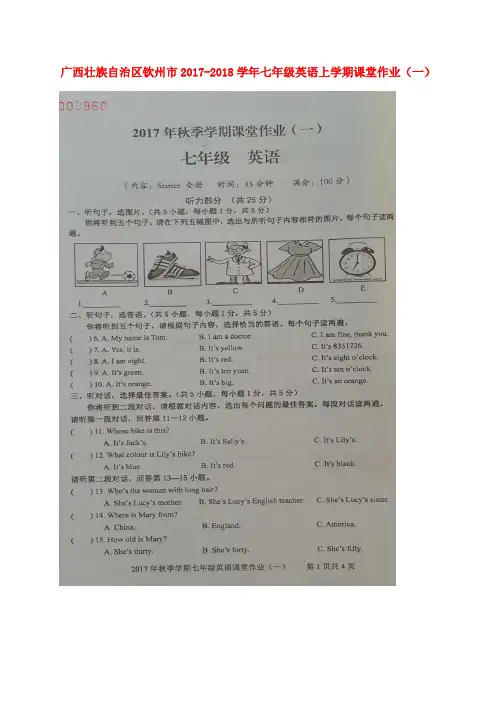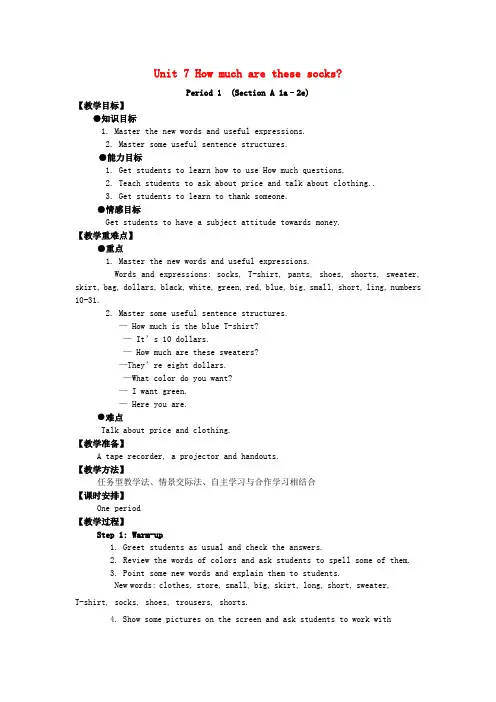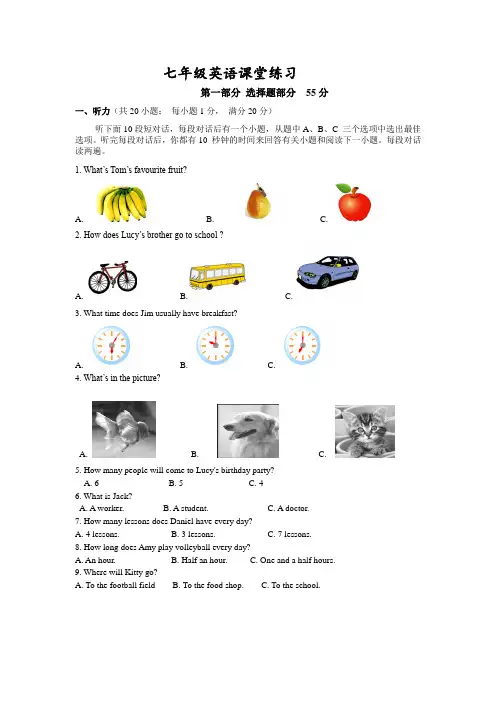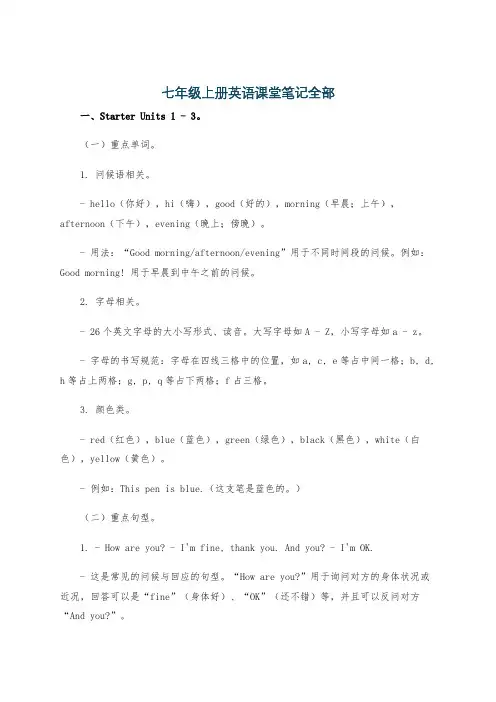(2017)七年级上册英语课堂
- 格式:doc
- 大小:43.50 KB
- 文档页数:1

广西壮族自治区钦州市2017-2018学年七年级英语上学期课堂作业(一)2017年秋季学期七年级英语课堂作业(一)听力材料及参考答案听力部分一、1-5: CEDBA 二、6-10: ACCBA 三、11-15: BCBCA 四、16-20: CCAAB笔试部分一、21-30: BCABC ACBBA二、31-35: eleven; short; white; homework; breakfast三、36-40: worker; boys; has; These; Whose四、41-45: of; at; Her; His; are五、46-50:CAEBD六、56-65: ACA BC BABCA 七、66-70: BCACB八、(略)听力材料一、1. My father is a doctor.2. It’s se ven o’clock.3. I have a new dre ss.4. These are my shoes.5. He likes playing football.二、6. What’s your name? 7. What’s your phone number?8. What time is it? 9. How much is the pen10. What colour is it?三、11-12:M: Good morni ng, Lily.W: Good morning, Jack.M: Can I use your bike?W: S orry, it’s not my bike. It’s Sally’s bike. Her bike is red and my bike is black.13-15:M: Hi, Lucy. Who’s the woman with long hair?W: She’s my English teacher. Her name is Mary.M: Where is she from?W: She is from America.M: How old is she?W: She’s thirty.四、My name is Jack. I am from England. I am twelve years old. This is my classroom. It’s very clean. There are twenty boys and fifteen girls in my class. There is a map of China in my classroom. We have four classes in the mornin g and two in the aft ernoon. I like English very much. Our teachers are very nice. We all like them.。

Unit 7 How much are these socks?Period 1 (Section A 1a–2e)【教学目标】●知识目标1. Master the new words and useful expressions.2. Master some useful sentence structures.●能力目标1. Get students to learn how to use How much questions.2. Teach students to ask about price and talk about clothing..3. Get students to learn to thank someone.●情感目标Get students to have a subject attitude towards money.【教学重难点】●重点1. Master the new words and useful expressions.Words and expressions: socks, T-shirt, pants, shoes, shorts, sweater, skirt, bag, dollars, black, white, green, red, blue, big, small, short, ling, numbers 10-31.2. Master some useful sentence structures.— How much is the blue T-shirt?— It’s 10 dollars.— How much are these sweaters?—They’re eight dollars.—What color do you want?— I want green.— Here you are.●难点Talk about price and clothing.【教学准备】A tape recorder, a projector and handouts.【教学方法】任务型教学法、情景交际法、自主学习与合作学习相结合【课时安排】One period【教学过程】Step 1: Warm-up1. Greet students as usual and check the answers.2. Review the words of colors and ask students to spell some of them.3. Point some new words and explain them to students.New words: clothes, store, small, big, skirt, long, short, sweater,T-shirt, socks, shoes, trousers, shorts.4. Show some pictures on the screen and ask students to work withtheir partners and make their own answers.5. Give students an example.A: What's this in English?B:It's a hat.A: What color is it?B: It's red.A: How much is it?B: It's ten dollars.6. Invite some students to act out their conversations.Step 2: Presentation1. Teach activity 1a(1) Ask students to read the words and conversations.(2) Show some pictures and match the words with the things in the picture.(3) Invite one student to read his/her answers.(4) Check the correct answers.Answers: i, d, a, c, f, g, j, b, h, e.2. Teach activity 1b(1) Ask students to listen to a tape and circle the thing they hear in 1a.(2) Invite some students to tell their answers.(3) Check the correct answers.Answers: hat, shorts, sweater.3. Teach activity 1c(1) Ask students to read the conversation and practice it with their partners.A: How much is this T- shirt?B: It's seven dollars.A: How much are these socks?B: They are two dollars.(2) Ask students to work with their partners and make their own conversations.(3) Invite some students to act out their conversations.Step 3: Practice1. Teach activity 2a&2b(1) Ask students to read the words in the box and try to recite them.(2) Ask students to listen to a tape and repeat.(3) Ask students to listen to a conversation and circle the things you hear.(4) Check the correct answers with the class.2. Teach activity 2c(1) Play the recording again and ask students to fill in the price tags.(2) Invite some students to tell their answers.(3) check the correct answers with the class.Answers: hat $5, sweater $8, shorts $6, T-shirt $7, socks $ 2, trousers $9.3. Teach activity 2d(1) Ask students to read the things in 2b again.(2) Ask students to work with their partners and make their oen conversations.(3) Give students an example.A: I like these shorts. How much are they?B: They are six dollars.(4) Invite some pairs to act the conversation out.Step 4: ConsolidationTeach activity 2e(1) Ask students to read the conversation and make sure they know the meaning of the conversation.(2) Ask students to work with their partners and role-play the conversation.(3) Invite some students to act out the conversation.(4) Explain some main language points.【课堂小结】In this period, we’ve learned how to do shopping and talk about prices politely. And we’ve also learned some language points.【课后作业】Write down the conversations between you and your partners.。




七年级英语课堂练习第一部分选择题部分55分一、听力(共20小题;每小题1分,满分20分)听下面10段短对话,每段对话后有一个小题,从题中A、B、C 三个选项中选出最佳选项。
听完每段对话后,你都有10 秒钟的时间来回答有关小题和阅读下一小题。
每段对话读两遍。
1. What’s Tom’s favourite fruit?A. B. C.2. How does Lucy’s brother go to school ?A. B. C.3. What time does Jim usually have breakfast?A. B. C.4. What’s in the picture?A. B. C.5. How many people will come to Lucy's birthday party?A. 6B. 5C. 46. What is Jack?A. A worker.B. A student.C. A doctor.7. How many lessons does Daniel have every day?A. 4 lessons.B. 3 lessons.C. 7 lessons.8. How long does Amy play volleyball every day?A. An hour.B. Half an hour.C. One and a half hours.9. Where will Kitty go?A. To the football fieldB. To the food shop.C. To the school.10. Who is the girl in the picture?A. Jack’s cousinB. Jack’s sisterC. Jack’s friendB) 听对话和短文回答问题你将听到一段对话和两篇短文, 各听两遍。
听每段对话或短文前, 你将有时间阅读相关小题, 每小题5秒钟;听完后, 每小题你仍有5秒钟的时间选出你认为最合适的备选答案。

Unit 7 How much are these socks?Period 2 (Section A Grammar Focus -3c)【教学目标】●知识目标1. Master the new words and useful expressions.2. Master some useful sentences.●能力目标Get students able to offer help and talk about clothing and prices.●情感目标Make students know that helping others is a traditional Chinese quality. 【教学重难点】●重点1. Master the new words and useful expressions.Words and expressions: need, woman, look, take, pair, a pair of.2. Master some useful sentence structures.Can I help you?I need a sweater for school.What color do you want?④It looks nice.⑤Two dollars for one pair and three dollars for two pairs.⑥I’ll take two pairs.⑦Here you are.●难点Talk about clothing and prices.【教学准备】A tape recorder, a projector and handouts.【教学方法】任务型教学法、情景交际法、自主学习与合作学习相结合【课时安排】One period【教学过程】Step 1: Warm-up1. Greet students as usual and check the homework.2. Review the words and expressions in the last period.Step 2: Presentation1. Grammar Focus(1) Ask students to read the conversations themselves.(2) Explain some important sentence structures and language points.(3) Ask students to work in pairs and practice the conversations.(4) Ask students to make their own conversations and invite some pairs to act out their conversations.2. Teach activity 3a(1) Ask students to read the words in the chart and try to recite them.(2) Ask students to make sentences in the chart with the words in the three boxes.(3) Give students an example.A: How much is the yellow T-shirt?B: It's seven dollars.(4) Invite some students to act out their conversations.Step 3: PracticeTeach activity 3b1. Show some pictures on the screen and ask students what they can see.2. Ask students to read the questions and answers.3. Ask students to try to complete the questions and answers according to the pictures.4. Invite some students to tell their answers.5. Check the correct answers to the whole class.Step 4: ConsolidationTeach activity 3c1. Ask students to work in group of two and student A look at the pictures in 3b for a minute and then student B ask questions.2. Give students an example.A: Ho much are he socks?B: Um, they are three dollars.3. Students ask and answer freely.4. Invite some students to act out their conversations.【课堂小结】In this period, we’ve further learned how to talk about prices through some writing and speaking practice. And we’ve also practiced our memory through a memory game.【课后作业】Write down one of the conversations between you and your partner in 3c.。

2017-2018学年七年级英语上学期课堂作业(二)(扫描版)新人教版2017年秋季学期七年级英语课堂作业听力材料及参考答案(二)听力部分一、CDAEB 二、CACBA 三、ABACB 四、BCABC笔试部分一、21-30: BACCA BCBAC二、31-35: classmate; member; classroom; cute; free三、36-40: sings; player; are; Jim’s; have四、41-50: is; helps; are; her; tall; looks; from; in; has; sing五、51-55: DAEBC六、56-65:CBADA BDBAB七、66-70: BADAC八、Hello! I’m kitty. I'm twelve. I come from Nanjing, but now I live with my family in Beijing. I'm not tall. My hair is very short, and I wear glasses. We have Chinese, Maths, English, Art and PE lessons at school. I like all the lessons at Sunshine MiddleSchool, and I'm good at English. I have some new friends at school. They are all very nice.听力材料一、1. My father loves reading. 2. Simon is a student.3. They like playing volleyball.4. She often plays tennis at weekends.5. She goes swimming every week.二、6. Nice to meet you.7. What’s your favourite sport?8. How old are you?9. Does he play football well?10. What time do you get up in the morning?三、11-12: W: Hi, Li Ming. Where are you from?M: I from Nanjing. What about you, Wei Fang?W: I’m from Shanghai. Are you in Grade 7?M: No, I’m in Grade 8.13-15: M: Hi, Sandy. What time do you often go to school?W: I often go to school at seven thirty.M: How do you often go to school?W: I often go to school by bike.M: What do you often do after school?W: I often play basketball.四、Millie is a new student at Sunshine Middle School. She is twelve years old. She has short hair. She loves reading. There are four。

Starter Unit 1 Good morning!Period 1 (1a–2e)【教学目标】●知识目标1. Learn to read and write letters Aa--Hh.2. Master the greeting sentences: Good morning. Hello/Hi!.3. Learn the meaning of some abbreviations.●能力目标Be able to greet each other using the target language.●情感目标Try to develop students’ interests in English and educate students to be polite.【教学重难点】●重点1. Learn to read and write letters Aa--Hh.2. Be able to greet each other using the sentences: Good morning/afternoon/evening. Hello/Hi!●难点Be able to greet each other using the target language.【教学准备】A tape recorder, some word cards, pictures and handouts.【教学方法】任务型教学法、情景交际法、自主学习与合作学习相结合【课时安排】One period【教学过程】Step 1: GreetingsThe teacher wears a name card with an English name on it, then points to the name card and makes a self-introduction.T: Welcome to my class. I’m your new teacher,... What’s your name?Give students several minutes, and invite every student to stand up to do a self-introduction for the whole class....Step 2: Lead-inListen to the ABC song.T: This is our first class. We’ll learn how to greet each other simply. Before learning, let’s listen to a song.Play the tape of the ABC song first, and ask students to listen carefully. Pay attention to the pronunciation and intonation.Then play it again, asking students to repeat after the song.Later, sing the song together.Step 3: Presentation1. Teach activity 1a(1) Ask students to open their textbooks, look at the picture carefully and find out the answers to the following questions:What can you see in the picture?How many students are there in the picture?What are they doing?Provide students with several minutes to think about the questions.(2) Read the conversation. The students listen and repeat.T:As we know, there are eight students in the picture.Who are boys, and who are girls? Write down their names on the lines.(3) Ask students to do this activity individually, and then check the answers.Answers:Boys’ names: Bob, Dale, Frank, EricGirls’ names:Grace, Helen, Cindy, Alice2. Teach activity 1b(1) Play the recording for the first time, and ask the students to pay attention to the pronunciation and intonation.(2) Play the recording for the second time. Ask the students to listen and repeat.(3)If students can’t listen to the conversation clearly, play it one more time.3. Teach activity 1c(1) Ask the students to practice the conversations in pairs. Move around the class when the students are practicing. Give them some help if needed.(2) Role-play the conversations in 1a in pairs.(3) Ask the students to practice greetings each other. They can use their Chinese names if they wish. Encourage them to use their English names if they can. Ask them to practice using all the different greetings taught in 1a.(4)Ask several pairs to act out their conversations for the whole class.4. Teach activity 2a(1)Show the 8 letters Aa--Hh on the screen, and teach students to read them one by one.(2)Play the tape, and ask students to pay attention to the pronunciation and repeat.(3)Invite some students to read these letters, and correct their pronunciation mistake if there is any.5. Teach activity 2bT: Now I’ll play the record. You’ll hear eight letters. Listen carefully andnumber the letters you hear.(1)Play the tape, ask students to finish activity 2b individually.(2)Play the tape again, ask students to check their answers.(3)Check the answers with the whole class.6.Teach activity 2c(1)Teach students how to write these big and small letters.(2)Ask students to copy the letters in their exercise books.Step 4: Practice1. Teach activities 2d(1) Ask students to read the letters in 2d and make sure they can read all the letters correctly.(2) Ask students to write letters Aa--Hh after the models. At the same time, ask one boy and one girl to write on the blackboard. While students are working, move around the room, checking progress and offering help if they needed.(3) Check the answers. Correct mistakes if any.2. Teach activity 2e(1) Show the pictures in 2e on the blackboard.(2) Ask students to read aloud the letters.(3) Choose a picture, and ask the students to say the abbreviations.T:What can you see in the picture?(picture one)S1:I can see a pencilT:Very good. Do you know the meaning of the letters below the picture? What does HB mean? Who knows?S2:It means hard black.T:Excellent....(4) Encourage the students to say more abbreviations and explain their meanings.Step 5: Consolidation1. Put students in pairs, and ask them to greet each other like this:S1: Hi!S2:Hello!S1:Good morning, S2.S2:Good morning, S1.As students work, move around the classroom and offer help if needed.Finally, ask some pairs to act out the conversations.2. Show the cards of the eight letters in disorder, and ask students to read the letters one by one correctly.Then, get students to work in pairs. One takes pictures, the other reads the letters. Do it in turns.【课堂小结】In this period, we’ve learned how to greet when we meet in the morning. And we’ve also learned how to read and write letters Aa--Hh, as well as some abbreviations.【课后作业】1. Listen and recite letters Aa--Hh.2. Recite the conversations in 1a.3. Copy these eight big and small letters five times.。

七年级上册英语课堂笔记全部一、Starter Units 1 - 3。
(一)重点单词。
1. 问候语相关。
- hello(你好),hi(嗨),good(好的),morning(早晨;上午),afternoon(下午),evening(晚上;傍晚)。
- 用法:“Good morning/afternoon/evening”用于不同时间段的问候。
例如:Good morning! 用于早晨到中午之前的问候。
2. 字母相关。
- 26个英文字母的大小写形式、读音。
大写字母如A - Z,小写字母如a - z。
- 字母的书写规范:字母在四线三格中的位置,如a, c, e等占中间一格;b, d, h等占上两格;g, p, q等占下两格;f占三格。
3. 颜色类。
- red(红色),blue(蓝色),green(绿色),black(黑色),white(白色),yellow(黄色)。
- 例如:This pen is blue.(这支笔是蓝色的。
)(二)重点句型。
1. - How are you? - I'm fine, thank you. And you? - I'm OK.- 这是常见的问候与回应的句型。
“How are you?”用于询问对方的身体状况或近况,回答可以是“fine”(身体好)、“OK”(还不错)等,并且可以反问对方“And you?”。
2. - What's this/that in English? - It's a/an...- 用于询问某个物品用英语怎么说。
例如:What's this in English? It's a book.(这个用英语怎么说?它是一本书。
)注意a用于以辅音音素开头的单词前,an 用于以元音音素开头的单词前,如an apple。
二、Unit 1 My name's Gina.(一)重点单词。
1. 名字相关。
- name(名字),first name(名),last name/family name(姓)。

Unit 3 Is this your pencil?Period 4 (Section B 2a–Self Check)【教学目标】●知识目标1. Master the new words and useful expressions.2. Master the target language.●能力目标1. Be able to read and write lost and found notice.2. Develop students’ writing competence.●情感目标Lead students to be honest and not to pocket the money that he/she has picked up. 【教学重难点】●重点1. Master the new words and useful expressions.Words: in, library, ask, some, find, lost classroom, e-mail, at, call, must, set Phrases: a set of2. Be able to read and write lost and found notice.3. Develop students’ writing competence.●难点Be able to read and write lost and found notice.【教学准备】Some lost and found notices, text book and handouts.【教学方法】任务型教学法、情景交际法、自主学习与合作学习相结合【课时安排】One period【教学过程】Step 1: Greetings and revision1. GreetingsT: Good morning, everyone.Ss: Good morning, teacher. How are you?T: Fine, thanks. And you?Ss: I’m OK.2. RevisionReview what we learned in the last period.Step 2: Lead-inT: Did you lose anything before?Ss: Yes.T: What things did you lose easily?S1: Keys.S2: Wallets.S3: Cell phones....T: Have you ever got back the things you lost?S1: Sometimes.S2: Never.T: OK. If we lose something, how can we get them back?S1: We can ask the police for help.S2: We can look for them in the place where they were missing. T: Anything else?S3: We can write lost notice to look for them.T: Good idea. Have you ever picked up anything?Ss: Yes.T: How can we return these things to the loser?Ss: We can take them to the police or write found notice.T: You are right. Today, we’ll learn how to write lost and found notice. Let’s begin.Step 3: Presentation1. Teach activity 2a(1) T: We all have many school things. We always lose some school things easily. Now discuss the school things you lose easily with your partner. Write them down on your workbook. Then report them to the class.(2) Students work with their partners.(3) Let some students report their things to the class.2. Teach activity 2b(1) T: Now. Read through the instruction so that you can know how to do this activity.(2) Ask students look at the pictures and read the notices on the board.(3) T: Tell me which ones are lost notice and which ones are found notice.Ss: The last one is a lost notice, and the other three are found notices.T: You are right.(4) Ask students to circle the lost things.(5) Check the answers.(6) Read the notices, and ask students to repeat sentence by sentence. Then explain the way of writing lost and found notice.3. Teach activity 2c(1) Ask students to read through the instruction of this activity so that they can know how to do it.(2) Leave students two minutes to do this task individually. Move around the classroom to check the progress and give some help if necessary.(3) Invite some pairs to check their answers.Answers:Step 4: Practice1. Teach activities 3a(1) T: Let’s work on 3a. Here are two notices but some words in the notes are missing. Read the notices and complete the notices with the words or phone number in the box.(2) Ask some students to read the words in the box. One read them in English. The other read them in Chinese.(3) Students read and complete the notices.(4) Check the answers.Answers: Lost; name; callFound; your; 284-54862. Teach activity 3b(1) T: As you have learned how to write lost and found notice. Now, let’s have a try. Write your own lost or found notice with your name and phone number.(2) Leave students several minutes to do this task.(3) As they work, move around the room, checking progress and offering help as needed.(4) Collect students’ notices. Choose the best ones to present to the whole class.Step 5: ConsolidationTeach Self Check1. Self Check 1(1) T: We’ve learned many school things. Now first review all the school things in three minutes. Then let’s have a competition. We’ll write the school things you can remember in a piece of paper. Let’s see who can remember the most.(2) Students review the words of the school things quickly. Then have a competition.(3) Check the numbers of the words on their paper to see who does the best.Answers: pen, ruler, pencil, pencil box, schoolbag, book, eraser, pencil, sharpener...2. Self Check 2(1)T: This part aims to help students to review the difference of pronounces.(2) Ask students to complete the chart individually. Do peer-correction with deskmates first.(3) Check the answers.Answers:3. Self Check 3(1) T: Look at the picture please. What are they talking about in the picture? Who would like to read it?S1: Is that your schoolbag?S2: No, it isn’t.T: OK, now what may other people (S2, S3 and S4) talk about in Picture? Write the conversation using Is this/that…? Yes, it is./ No, it isn’t. Are these/those …? Yes, they are. / No, they aren’t.(Students write the conversations with their partners.)(2) T: Now please read the conversation with your partner.S3: Is that your notebook?S4: Yes, it is.S5: Are those your keys?S6: No, they aren’t.…(3) Now practice the conversations with your partners.【课堂小结】In this period, we’ve mainly learned how to read and write lost and found notice. And we’ve also consolidated how to identify ownership.【课后作业】1. Review the new words and useful expressions in this period.2. Read the messages again and again in 2b.3. Write two notices using the target language in this unit.4. Preview the next unit.。
Starter Unit 1Good morning!第一课时(1a2e)1.字母:Aa—Hh的读音、笔顺和笔画2.重点单词:good,morning,hi,hello3.重点句式:—Good morning.—Good morning.1.掌握字母Aa—Hh的读音及书写2.能够问候他人1.能够问候别人2.能询问对方的姓名及回答对姓名的提问Step 1情景导入Teacher:Hello,everyone.Nice to meet you!This is our first lesson.I am very glad to learn English with you.Do you like listening to music?Do you want to listen to music now?Now I will play an English song for you.Please listen carefully.It's very easy to understand.Let's begin.环节说明:通过听音乐这一环节激发学生的学习兴趣和学习英语的热情,让学生在听歌曲的过程中进入新课的学习。
Step 2完成教材2a—2e的任务1.学生跟唱字母歌,初步感知字母读音。
(3分钟)2.听2a录音,学生跟读,然后两人一组互相读2a中的字母。
邀请多位学生读出字母,教师随时纠正读音。
(5分钟)。
3.再听一边录音,根据所听到的顺序为字母编号。
集体按顺序读出听到的字母,核对答案,完成2b。
(2分钟)4.让学生认真观察2c中字母的笔顺和笔画,在练习本上练习字母的书写,让几个学生到黑板上板演,教师点拨易错点。
(3分钟)5.学生练习字母的书写,书写熟练后两人一组互相默写字母。
(3分钟)6.认真观察2d中的字母,写出它们相应的大小写字母,小组内交流,核对答案。
(2分钟)7.小组内互相交流自己见到过的字母组合及其它们的含义,比一比谁知道得多。